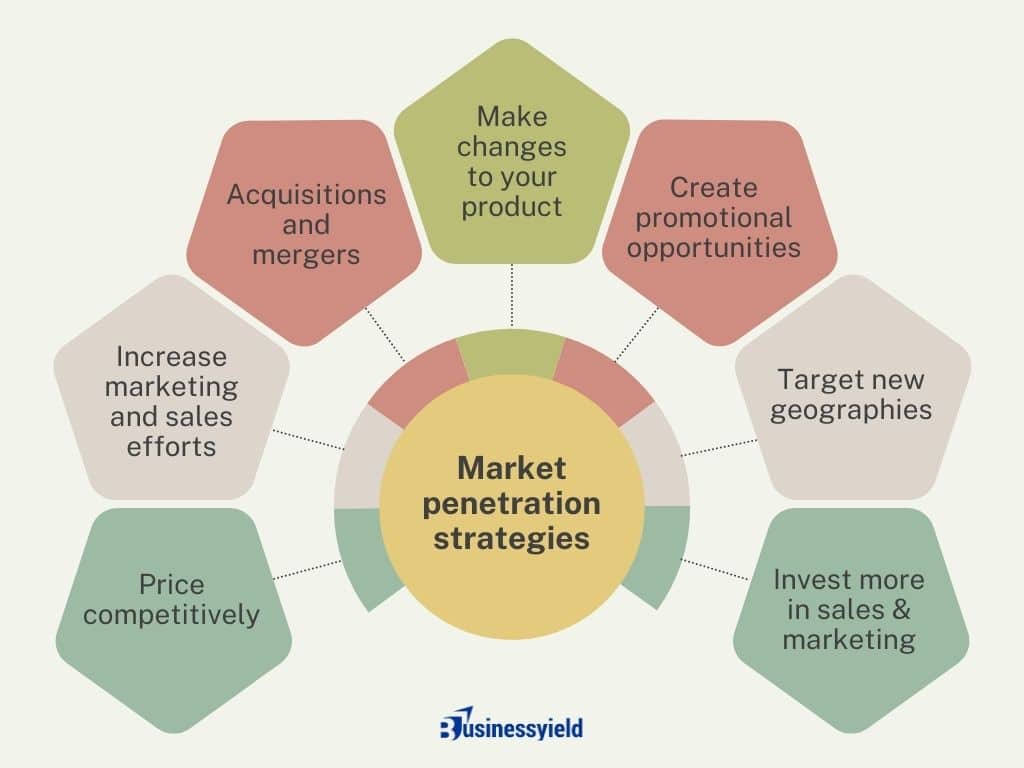The premise of market penetration is simple: it is a measure of how much of a product/service that customers actually use compared to its total estimated market. A company can use market penetration at the industry level to review the potential for specific products or services or on a smaller scale as a way to gauge the market share of a product or service.
In a nutshell, it offers insight into how the market and your customers view your product or service. It can also be used in developing strategies employed to increase the market share of a particular product or service.
That being said, what strategies can you employ in line with market penetration? And how can you use it to increase sales? Those are the questions I will answer in this article.
Key takeaways
Market penetration defines how much of a company’s product is being sold relative to the total estimated market for that product, expressed as a percentage.
It is also the process of going to market with a product in an existing market where current or similar products are already live and taking market share from the other competing companies.
A market penetration strategy can help increase a brand’s customer base and revenue.
By identifying your company’s current share of the market and comparing it to the demand, you can then create a penetration strategy.
Understanding the different strategies and how to apply them can help increase your brand’s market share.
Understanding the concept of market penetration
Market penetration can be defined in two ways: either as a measurement or an activity.
As a measurement, it defines how much of a company’s product is being sold relative to the total estimated market for that product, expressed as a percentage. This is also known as the market penetration rate.
If you know your total addressable market (TAM), you can calculate the market penetration rate with this formula:
Market penetration rate = (number of customers ÷ target market size) x 100
Establishing market size can be tricky depending on the nature of your SaaS product, as a potential customer base could be global and essentially target “everyone.” The more granular you can get with your ideal audience demographics, the easier it will be to make this calculation.
Read also: Saas Marketing: Overview, Plans, Agencies and Strategies (Updated)
As an activity, market penetration is the process of going to market with a product in an existing market in which current or similar products are already live and taking market share from the other competing companies. This is also known as a market penetration strategy.
The term market penetration (defined as an activity) stems from the Ansoff Matrix, developed in 1957 by Igor Ansoff, which helps companies plan their strategies for future growth. The Ansoff Matrix is a 2X2 matrix representing four different business growth strategies in which a company either enters a new or existing market and with either new or existing products.

Market penetration can be used to determine the size of the potential market. If the total market is large, new entrants to the industry might be encouraged that they can gain market share or a percentage of the total number of potential customers in the industry.
Types of market penetration strategies
There are a few different types of market penetration strategies you can use with your company, including:
Market penetration pricing
Adjusting pricing is one of the most common market penetration strategies. For a company to take market share from another that already has a customer base, their product either must be of better quality or come at a lower price. This does not always mean cheaper because market penetration pricing adjustments can also include offering a new type of payment plan or providing more value for the cost.
A common method that some brands use is to offer competitive pricing until they have a good percentage of the market share.
Related: A Guide to Implementing Prestige Pricing Strategies for Business Owners
Market penetration marketing and promotions
Some brands may achieve market penetration by increasing their advertising efforts or promotions. These strategies increase brand awareness, which can be important for gaining more customers and more market share. Brands can also use marketing and promotions to achieve brand loyalty or to use emotions to connect with the customer.
Many brands may also use market penetration marketing and promotions in combination with pricing.
See: Understanding Consumer Behavior: A Comparative Analysis between Gen Z and Millennials
Product updates
Some brands may also decide to make updates to their product as a part of their market penetration strategy. By learning customer preferences or offering a higher quality product, brands can earn more of the market.
Certain brands may also use new product development to achieve the same results. They can diversify their offerings and add new products to their existing inventory to attract a new type of customer.
Acquisition
Acquisition is the process of merging two entities to create a partnership. It can also occur by buying out a competitor. With each of these actions, you combine your market share with the other brand’s share for a larger percentage of the overall market.
Some brands may choose to maintain the previous brand’s name and reputation, whereas others may choose to merge everything into their own brand.
Market penetration strategies

A market penetration strategy is when a company works towards a higher market share by tapping into existing products in existing markets. It’s how a company (that already exists in the market with a product) can grow business by increasing sales among people already in the market.
When a company tries to implement growth strategies, there are often four ways of doing so: developing new markets, diversifying into new products, penetrating existing markets, or developing new products. These four strategies are depicted in the Ansoff Matrix.
Since the strategies that require new markets or new products are considered riskier, market penetration is often the lower-risk option for growth. This is because the market has already been created and can be studied. In addition, the company may already be offering a product or a variation of the product.
Below is a checklist containing expert strategies for achieving success in market penetration:
Market penetration strategy
Growing in an established market is a relatively safe bet because it means there is already a need for your products or services. However, it requires implementing smart product positioning, pricing, user experiences, and marketing tactics in order to compete and grow alongside dominant companies in the market.
Below are additional tactics that you can use in your market penetration endeavor:
Create a new product
Though market penetration often occurs with existing products, a company may be able to solve a customer’s problem innovatively with a new good. Though this riskier option does not guarantee market adoption, a company may invest in research and development to study existing products and analyze gaps in value.
With this, you can detect where existing products fall short of consumer expectations, and manufacture a new good.
READ MORE: What Is Product Development? An Expert’s Guide For Product Developers and Managers
Create promotional opportunities
If your company does not want to permanently discount prices, you can penetrate markets by offering temporary promotional opportunities. This strategy lures consumers in by attracting them to low prices.
Note, though, that while this may result in short-term success, it is more likely to attract the wrong audience. Especially if you are striving to be a higher-quality (and therefore higher price) company.
Invest (more) in sales representatives
You may have everything you need to successfully bring a product to market. However, your product may falter if you do not have the appropriate staff on hand.
No matter how strong a manufactured product is, a company must be able to bring it to the market, communicate its value, and close sales. This may require you to increase the headcount of sales reps or invest more heavily in stronger talent.
SEE: SALES REPRESENTATIVE: Definition, duties, salary, skills & development
Target new geographies
With the proliferation of online sales, many businesses may already have access to wider markets than they realize. Even if your company is restricted to one geographic region, you may employ the market penetration strategy of moving, developing, and expanding to a new area.
Without having to leave its original location, your company may be able to fund operations in a new site by leveraging success at an existing site.
How to create a market penetration strategy
In addition to the strategies listed above, you can create your own market penetration strategy with the following steps:
1. Calculate market penetration
Before developing your market penetration strategy, you can first calculate the items’ market penetration rate. This calculation can help you learn how much a product or service is in demand by customers in the market. It can also give you a better idea of how much of the market is available for you to take.
Research how much of the current market share you have so you can update the numbers after implementing each strategy to determine its success rates and make adjustments.
2. Identify your brand’s strengths
It can also be helpful to consider how your products and the overall brand compare to your competitors in the market. This can help you choose the right penetration strategy. Write a list of the most important things to consider about your company and the others in your market, like pricing, product availability, quality, and location.
Note which areas your business is most successful and where you can make improvements.
READ: Brand Building: Best Strategies and Insights from Leading Brand Consultants
3. Choose a strategy or combination of strategies
After conducting research, you may know what strategies could work best for your brand. You might decide to reduce pricing or improve the quality of your products. You might even partner with, or buy out, a similar brand in order to capture more of a specific market.
Pick a strategy that aligns with your target audience and your overall company goals.
4. Decide how to measure progress
Determine how long it may take to see results after implementing your penetration strategy. Set a specific timeline and then recalculate the market penetration rates to look for changes. Determine the success of your strategy and if you’ve captured the expected amount of market share.
You might try another strategy to supplement your original or to try to gain even more of the market share.
Advantages and disadvantages of market penetration
Advantages
For most companies, increasing their market penetration will increase sales. That’s because market penetration strategies often entail increasing the number of customers served or more deeply becoming engrained in the larger customers they serve.
You can also leverage successful market penetration by being more strategic with what you offer customers. Instead of being a price taker, you can use your deeper presence in a market to set your own price and sales terms or enhance your products as you see fit.
In many ways, market penetration can only occur through product differentiation and being able to convey unique benefits to consumers.
SEE: Understanding Innovation in Business: Definition, Types & Benefits
Market penetration also leads to higher visibility of products or services, and markets may begin to better recognize the benefits your company may be able to offer. This allows your brand equity to increase, as public perception of a company is most often improved as the company penetrates new markets.
Disadvantages
Though market penetration may improve operations, there is also the risk of it backfiring.
When you seek out new markets or offer new products, you always run the risk of diminishing your brand’s existing image. You could end up creating wrong public perceptions about your company or attracting a client base that does not align with your strategic plan. As products become less popular, you may be forced to liquidate products by selling them at a discount if they no longer resonate with consumers in markets you penetrated.
Though companies often perform market segmentation to attempt to attract the right customers, market penetration may increase the risk of the wrong customers being served. This can be detrimental to a marketing plan that strives to cater to a certain customer willing to pay certain prices for a certain quality of goods.
Should Apple accidentally attract consumers who want to pay the lowest prices in the market, it will face a dilemma in trying to retain those customers or shifting its marketing plan.
Market penetration may also sound like a single instance of garnering a deeper market presence, but it is actually a company-wide strategy that requires everyone to be on the same page. Consider how the manufacturing, warehousing, procurement, or selling departments may not be aligned. This puts undue pressure on some departments that may need to play catch-up as markets are penetrated.
Real-world examples of successful market penetration strategies
Industry giants like Facebook and Microsoft regularly snap up smaller companies in order to expand their businesses and further penetrate markets. This emphasizes the importance of acquisition in the SaaS industry.
Diet Coke was a huge hit, but it attracted primarily female consumers. What was Coca-Cola’s solution? Coke Zero, which is essentially the same in terms of taste and benefits, but squarely positioned and marketed to capture the male market they were missing.
Samsung is well known for its penetration pricing strategy. By offering its phones at a lower entry price with more pricing tiers, it aggressively lured consumers away from Apple to become a fierce competitor in the global smartphone market.
Apple has consistently introduced new versions of its iPhones with added enhancements and upgrades. As a result of its market penetration, Apple has a larger market share than all of its competitors combined (29.27% as of January 2024).






